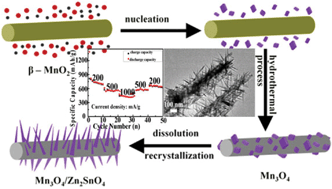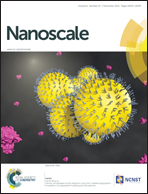Facile synthesis of one-dimensional Mn3O4/Zn2SnO4 hybrid composites and their high performance as anodes for LIBs†
Abstract
One-dimensional (1D) Mn3O4 nanorod/Zn2SnO4 nanoneedle hierarchical composites were conveniently synthesized via a simple hydrothermal process at 180 °C for 24 h. It was found that the reaction time and an appropriate amount of ammonia play vital roles during their formation process, and their formation is likely driven by the lattice match of the cubic Zn2SnO4 nanoneedles and cubic Mn3O4 nanorods. The as-obtained composites deliver a high initial discharge capacity of 1370.9 mA h g−1 at 100 mA g−1 in the range of 0.01–3.0 V, and a reversible specific capacity of 577.4 mA h g−1 could be retained after 50 cycles. It is noteworthy that 441.5 mA h g−1 could be maintained after 50 cycles even if the current density was set as high as 1000 mA h g−1, and the rate performance of nanocomposites (200, 500, 1000 mA g−1) also shows excellent reversible character. The high specific capacity, good cycling stability and high rate performance of the as-obtained composites enable them to be promising and competitive high-performance anodes in lithium-ion batteries (LIBs). It is worth noting that the fabrication method reported here can be easily extended to prepare other 1D metal oxide hybrid materials including Mn3O4/ZnFe2O4, Mn2O3/CoFe2O4 and Mn2O3/NiFe2O4 composites via a similar hydrothermal process with/without subsequent calcination, which hold great promise for their wide potential applications in energy, catalysis and environmental science and technology.


 Please wait while we load your content...
Please wait while we load your content...